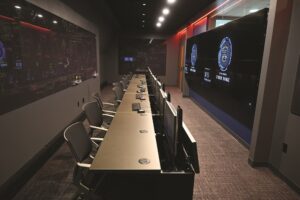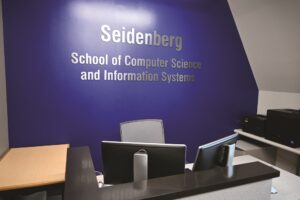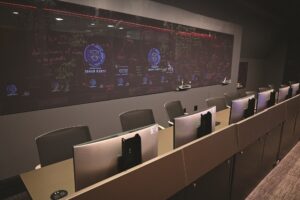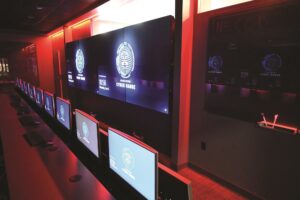Pace University students are getting firsthand experience on combating cybersecurity threats and preparing for a career in that field thanks to an immersive cybersecurity lab that combines the best of both worlds covered in CI+SSI: AV and security.
Thanks to a fully reconfigurable videowall that allows instructors and students to adjust on the fly based on their needs and engage in hack-a-thons among themselves and with other schools.
The key, according to the key players involved in developing the Seidenberg Cyber Range at Pace University, is the fact that AV integrator CTI was part of the planning from the very beginning, meaning technology was a critical component rather than an afterthought.
“Our Pace University Seidenberg School of Computer Science and Information Systems is an ever-growing and amazing program, which I’m a graduate of myself. And we’re always looking to build what’s coming next,” says George Chacko, director at Pace University.
“Cybersecurity the newest thing. Cyberthreats are everywhere; cybersecurity jobs are on the rise,” he says. “The traditional teaching and learning methodologies of the lecture hall, that’s fantastic. But there is no learning like hands-on learning, dealing with real-time situations, defusing real-time situations, whatever they may be.”
Chacko continues, “That was one of the reasons that we built a cybersecurity lab, and the School of Computer Science and Information Systems came to us to help design this room. Obviously, we couldn’t think of a better partner than CTI to work on this project. Working on this project has been very fulfilling, watching the students in there and everything like that.”
Already Exceeding Lofty Expectations
Kristofer Nikolaj, senior IT project manager at Pace University, says the Seidenberg Cyber Range and the related cybersecurity program has “expanded past just course curriculum.”
In addition to the hacking competitions, Pace University has a separate team where they recruit students throughout the CSIS program and create their own cybersecurity team, he says.
“They’re practicing on off hours and actually participating in competitions with other universities and local colleges as well,” says Nikolaj. “This room actually serves as a dual purpose of them actually having an actual training facility. So, that’s when we started gathering all their needs. They really wanted something that was fully immersive to the students.”
Nikolaj continues, “Previously, they were put into a room that had some technology and had AV in it, but it wasn’t necessarily that kind of full experience for cybersecurity and hacking. Once we started meeting with the clients, that’s when we started talking about the needs and it’s everything from aesthetics to the technology and finally bringing this vision to fruition.”
Early AV Involvement Enhances End Result
George Fournier Jr., CTS, design engineer in CTI’s New York metro office, says the company was “very fortunate that we were brought into the project very early on, before the space was actually going to be reclaimed from another classroom.”
According to Fournier, “We were so far in front that we were actually able to develop the architectural drawings for the architectural team at the front end, so that we could make sure that the technology was going to be in place that was not going to impede the ADA compliance and all that other stuff, but also help with that immersion experience for the students to use.”
A Massive 4×2 Videowall
The Seidenberg Cyber Range features a massive 4×2 videowall and a large desk with embedded computers that have displays that raise up and go back down again, along with signal management within the room and seamless control for the users, says Fournier.
“It was great that we have this relationship with Pace, because I was able to talk to their facilities team and actually find out how the space was going to be, what the schedule was for the space’s construction phase, the network team, the AV and the classroom development team as well,” he says.
“It wasn’t like, ‘OK, we just stuck some TVs on the wall and just put some PCs out,’” says Fournier. “It was actually, ‘what are they going to try to do? What’s their use case? What type of experience do we want those students to gain from using this space?’ That was a unique approach to this room.”
He continues, “Then to actually see it in action, I was like, ‘Wow the students and the teachers are using this in a way that I wasn’t even thinking they’d be using it.’ It’s really been impressive to see.”
Fournier worked with the facilities team and the architects to help them get their approvals, then helped them generate the drawing sets that they needed. He also helped the general contractors make sure the cable paths, ventilation and other technology infrastructure were considered.
That three-month endeavor started in the winter of 2022 and ran into the spring of 2023, says Fournier, so they could do the bulk of the installation when classes were out in the summer. In all the process ran for about nine or 10 months from start to finish, he says.
CTI was “right behind the sheet rock, right behind the painters, right behind the furniture team, getting technology and up and running, tested so the students and the teachers could get in there late summer to actually start testing it and using it to see how they want to do it,” says Fournier.

The Seidenberg Cyber Range’s massive 4×2 videowall is fully reconfigurable, allowing instructors and students to adjust on the fly based on their needs and engage in hackathons among themselves and with other schools. Photo courtesy of George Fournier Jr., CTS
“I cannot emphasize how critical it was that they got involved as early as they did in this project,” says Chacko. “AV is often forgotten in projects like this. We come in after the walls have gone up sometimes. If we are allowed to get in on day one, we would avoid so many opening day issues and day two issues.”
“Usually, the AV team comes in as they’re taking the plastic off the chairs,” says Fournier with a laugh. “Especially for this application, [doing] that would have been way too late. This room was really designed around the technology.”
Fournier continues, “It was a very refreshing experience to be that early into the job and to follow it all the way through. I love bragging about this project because of that. It’s like we wanted to write a textbook on how you do this. This is the way you deliver a project.”
“The biggest thing that was highlighted with this project was collaboration,” says Nikolaj. “We had this videowall with a total of eight displays. With the great design from (Fournier) and his team, this videowall can be set up and using different orientations, so we can split the content from each student station. It can be split in half or split into four displays.”
Nikolaj continues, “The students were able to kind of piggyback off each other, and especially when it comes to teamwork, and hacking, they’re able to see what somebody else did — what they did right, what they did wrong and learn from each other. You obviously had the tech, but this collaboration aspect and being able to do that much more with this room was a huge thing for this project and this room.”
Room to Grow
Fournier says that CTI made the Seidenberg Cyber Range “future resistant.” But Nikolaj, for his part, is even more definitive. He doesn’t see anything that needs to be added to or changed in the space.
“The early involvement helped eliminate all the issues,” he says. “CTI and [Fournier] were consistently coming and making these little adjustments just to really tie that bow on a project like this.”
Nikolaj continues, “Maybe as the team gets larger, maybe a bigger space, there will be other things we want to add, but, with the space that we have now, I’d say we did a great job. CTI did a fantastic job tending to the needs and the feedback of the end users.”
“It was two rooms that were consolidated into one room,” says Chacko. “We took down some walls and stuff. There was some glass up there that was serving no purpose and there were all these variables there.”
Chacko continues, “We had discussed that we were going to put the rack in a room adjacent, or maybe behind this particular room and [Fournier] came in and said, ‘Hey, why don’t we just use a ceiling rack and leave it in the room, so we don’t have to worry about runs?’ When you build a cybersecurity lab, you’re really just helping students build a shield for tomorrow’s digital threats, so to speak, and you want to give them the opportunity to be in a situation, be in a war room.”
“We have a 4×2 wall. So, I put one up on one quadrant, and I’m looking at IP addresses on one and looking at threats on the others. I’m looking at the whole situation,” says Chacko. “There are so many things you could do. There’s so much flexibility in the room. It is thoroughly impressive to watch.”
“That was part of what we looked at from the technology side of it,” says Fournier. “Also, as [Chacko] mentioned, we put everything in a ceiling box in the room so there’s a dedicated AV-over-IP network within the room so each one of the displays has their own decoder, each student station has its own encoder for its dedicated PC. The teacher station also has a laptop connection encoder, and then also a dedicated PC connected to a second encoder.”
Fournier continues, “We came up with the layouts, and Kris got feedback from the actual users on what the typical layouts would be. I can take one computer and take up half the videowall with that and take another one and put it next to each other, or I could do it in thirds and I could put the teacher’s example next to it. We laid it out so that it was very easy to use.”

Pace University’s Seidenberg School of Computer Science and Information Systems boasts an ever-growing program. Photo courtesy of George Fournier Jr., CTS
“So, now, at a later date, if they want to put in another 10 computers, we can do that because the network is designed that way so that we can actually just add to it. If we needed to make the wall bigger without having to rip everything out, start all over again, so that infrastructure being there made it future-resistant,” says Fournier.
If the PCs aren’t in use, a Pace University Cyber Range logo comes up on the videowall, to give students the full immersion effect, he says.
“When they walk into the room, everything’s been painted black,” says Fournier. “The ceiling tiles are black, the lights are at a lower light, so it’s actually like they’re working walking into a network war room. It gets them all into that that type of mentality. They actually start working on these battles that are just amazing to see.”
“That color scheme of the room is something else,” says Chacko. “When you walk in, you really can’t have any distractions. Anything distracting needs to be shut off. You need to be focused on your situation.”
“In addition to that, they even put RGB LED strips in the front of the room, so when they simulate a code red, they actually have a control panel and they’ll actually set the LEDs to red,” says Nikolaj. “It gives them that full immersive experience of a code red situation, and they’ll change it and change the colors as the situation either decreases in severity or increases.”
Because the CSIS instructors and professors are largely tech-savvy, that streamlined the training process, says Nikolaj.
“I would just pop in there on my own to go check on things and just happen to run into the lead instructor and it was a matter of probably half an hour just walking them through the touchpanel,” he says.
“CTI, with the help of the Q-SYS devices in the layout, couldn’t have made the layout and their interaction with the touchpanel and control system any easier,” says Nikolaj. “It was extremely straightforward. It took me about a half hour’s worth of training and walking through the instructor through everything.”
The Seidenberg Cyber Range could lead to more classes and opportunities for students looking to improve their cybersecurity skills, says Chacko.
“I know they’re developing several new courses,” he says. “I think cybersecurity was something recently approved as a major, so they’re constantly developing new course material. Every time I go there, someone is in there.”
Fournier is happy that the lab is being used whether class is in session or not.
“It was nice to see the last time I was up there that, even though a class was not currently in there, there were still students in there running simulations and doing stuff,” he says. “And the professor was there, too, actually working on his next lecture plan.”

The large desk, at which students sit, has embedded computers that have displays that raise up and go back down, as needed. Courtesy / Pace University
Overcoming Supply Chain Obstacles
The biggest issue that CTI had at the start of the project was simple: The technology manufacturers were still coming out of COVID-19 delivery timeframes, an issue magnified by supply chain snarls that limited the original design intent.
“As we were proceeding, we were actually able to upgrade some materials within that we weren’t originally planning on because they became available again,” says Fournier. “For the most part, we were pretty straightforward and didn’t have a lot of concern from the technology front.”
Fournier continues, “As Kris worked more with the professors and found out, ‘We want to add audio; we want to do this,’ it was sort of like, ‘OK, we need to go back to the drawing board without yanking everything out [and] see what we can do. [We need] to get back with some of the manufacturers and find out there’s some bells and whistles that these devices have that they really don’t advertise, or that people don’t use that often.’”
“Then, I was able to work with the CTI programming team to add some of those features,” says Fournier. “For instance, on the encoders for the student PCs, the top-of-the-line model has audio outputs and all this other stuff we had used the standard encoders, thinking that we were just going to use video.”
Fournier continues, “And then, when they asked for audio, we found out that, because it’s a HDMI backbone, we were actually able to split that off within the system and then use that as routable within the system as well, and that saved us having to run extra cables to each location, or possibly having to yank those encoders out and start all over again.”
Originally, CTI had the touchpanel sitting on the table, but the professors preferred to have it on the wall. So, Fournier and his team had to go back and install it on the wall. “But,” he attests, “for the most part, there wasn’t any drastic changes.”
Now that the Seidenberg Cyber Range has been so successful on one Pace University campus, Fournier and CTI are talking about replicating them at the school’s other locations.
“To be able to expand it or change it in the future is one of the key things we put in there. We used existing technology,” he says. “We didn’t reinvent the wheel to make this room. It was just more of the application and the way that it was being used in this particular application was something that we hadn’t thought of.”

If the PCs aren’t in use, a Pace University Cyber Range Logo comes up on the video displays, thus giving students the full immersion effect. Photo courtesy of Pace University.
According to Fournier, “There’s a whole division of my company who do command and control rooms for some of the larger Internet companies and telecommunication companies in the world, so they’re used to doing this on a large scale.”
“For us to actually come in and be able to do it at a smaller scale, but still give that type of effect for the students was key and I think that’s something that differentiates us from other integrators,” he says.
CTI is involved with Pace University’s summer refresh, updating as many as 90 classrooms across its three campuses. That can encompass everything from tracking cameras, to ceiling microphone arrays, to replacing end-of-life devices, says Chacko.
“We have a dedicated team that will be working with Pace, basically living there for the summer, and they do have three so we’re going from Pleasantville, N.Y., to New York City and Westchester, obviously,” says Fournier.
Chacko is exceptionally proud of the results of the Seidenberg Cyber Range, and he sees it as a model that other universities should aspire to have.
“We pride ourselves in preparing our students and arming them with the absolute necessary tools to be ready for day one of their jobs,” he says. “This room is a perfect example of how we prepare our students.”
“That crossover between being an AV in a security realm type of story is because of that prep that Pace University does for their employees, for the students,” says Fournier. “My son is about to be a junior in high school, but he’s looking at this stuff now and saying, ‘That’s a whole part of the world I didn’t even think about.’”
“When you have students that are coming up like that — when they can get this kind of experience — they’re walking out of Pace University with their certifications and having [had] actual, real-world experiences. Their ramp-up time when they get to an employer is definitely reduced, and it’s a very positive outcome for the person who hires them and [for] the employee, as well. That is very encouraging, amazing to watch,” he says.
“We might not flatten the curve, but we’ll definitely reduce it,” says Chacko.
“That’s the one thing that the CSIS group is kind of highlighting, too,” says Nikolaj. “It’s not just teams or classes. It’s researchers, as well. They’re encouraging students actually go in there on their own and research different tactics and methods, vulnerabilities, etc.”
Nikolaj continues, “We have some spaces that are almost siloed to a certain type of group or a certain use case, whereas this room is for teams and training, but also for students to continue expanding on their wheelhouse and sharpening their skillsets. It’s an incredible room in that sense.”
This post was originally published on 3rd party site mentioned in the title of this site





